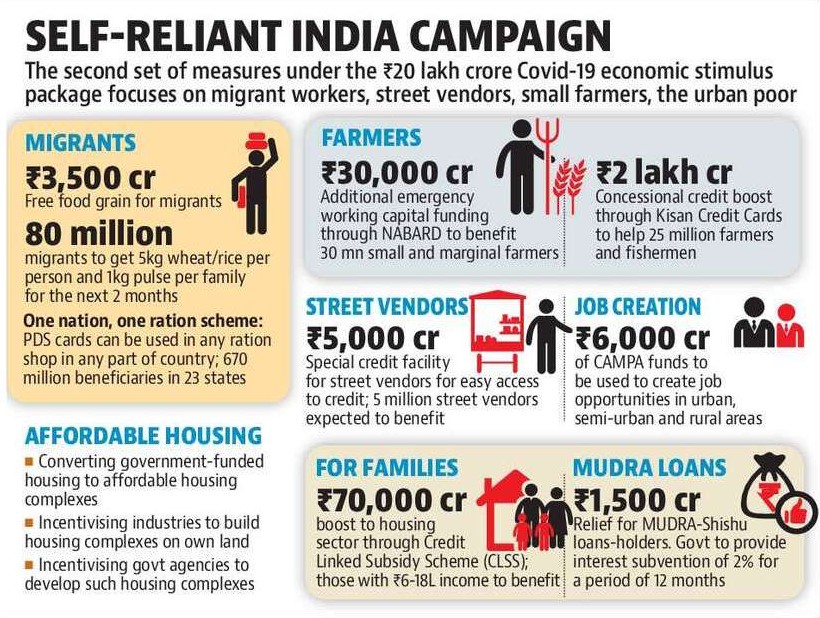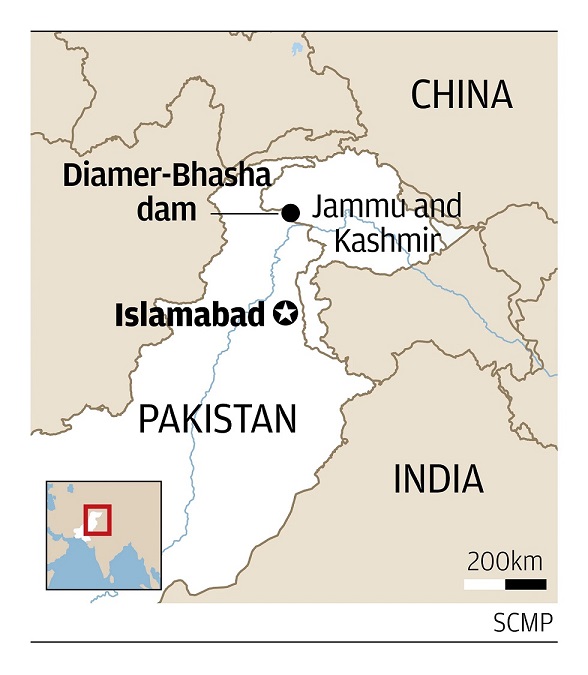Contents
- Second Tranche of Economic Stimulus Package
- Diamer-Bhasha Dam: Claims over Gilgit-Baltistan
- India non-committal on talks with Taliban
- NHRC issues notices to States
SECOND TRANCHE OF ECONOMIC STIMULUS PACKAGE
Focus: GS-III Indian Economy
Why in news?
- The major focus of the second tranche of the economic stimulus package announced on 14th May 2020 is to provide free food grains for the next two months to migrant workers who do not have ration cards.
- The Centre will help create affordable rental housing for the urban poor and provide relief worth ₹1,500 crore to small businesses through an interest subvention scheme, apart from extending credit for street vendors, farmers, and middle-class housing.

Helping Migrant Workers without cards
- There are an estimated 8 crore migrant workers who have been housed in government and privately-run relief camps across the country since the lockdown.
- The move to provide free food grain for migrant workers is an extension of the Pradhan Mantri Gharib Kalyan Yojana, which provided an additional monthly free rice or wheat allocation of 5 kg per person, and 1 kg of pulse per household from April to June to the 80 crore people with ration cards covered by the National Food Security Act (NFSA).
- Migrant workers and others without ration cards have struggled without access to this free food.
- Most of these migrants who have no cards are staying in camps run either by the government or by NGOs.
- Food Ministry data shows that inter-State transactions under the scheme have been very low, around 200 per month, since the lockdown due to poor awareness and the stalling of biometric authentications due to the pandemic.
- By August 2020, the ration card portability scheme will allow 67 crore NFSA beneficiaries in 23 connected states to use their cards at any ration shop anywhere in the country, allowing migrant workers to access subsidized food away from their home villages.
- The need of the moment was to universalize the Public Distribution System to provide food to whoever needed it.
People who are ‘Cardless’ and without food in India
- There are 50 crore people in the country without ration cards, of which 10 crore people are legally entitled to PDS grain under NFSA.
- OF the remaining 40 crore people there are many people who were managing in normal times, vegetable vendors, gig economy workers, autorickshaw drivers, who are in dire straits now.
- The measure to keep MGNREGA work open during the monsoon, known as the “hungry season” will be very helpful.
Affordable housing
- Migrant workers and other urban poor face difficulties in finding affordable housing.
- A scheme to build rental housing complexes through public private partnership mode would be launched under the existing Pradhan Mantri Awas Yojana (PMAY) scheme, to help the poor to afford housing.
- Both public and private agencies will be incentivised to build rental housing on government and private land, while existing government housing will be converted into rental units.
The credit linked subsidy scheme for lower middle class housing under PMAY will also be extended by one year to March 2021, and is likely to benefit 2.2 lakh more families.
Subvention relief
- Street vendors who have been hit hard by the lockdown will be given access to easy credit through a ₹5,000 crore scheme, which will offer ₹10,000 loans for initial working capital.
- Small businesses who have taken loans under the MUDRA-Shishu scheme, meant for loans worth ₹50,000 or less, will receive a 2% interest subvention relief for the next year.
-Source: The Hindu, Hindustan Times
DIAMER-BHASHA DAM: CLAIMS OVER GILGIT-BALTISTAN
Focus: GS-II International Relations, GS-I Geography, Prelims
Why in news?
- India on 14th May 2020 opposed a move by Pakistan and China to build a major hydropower plant in the Gilgit-Baltistan region, saying it has shared its concerns regarding such projects with both countries.
- The Pakistan government on, 13th May 2020, signed a Rs 442-billion contract with a joint venture formed by China Power and the Frontier Works Organisation (FWO), a commercial arm of the Pakistani military, for constructing the Diamer-Bhasha dam.
- Indian Ministry of External Affairs reminded China about India’s claims over the territory of Gilgit-Baltistan under Pakistan’s control.
Details
- The eight million-acre feet reservoir with a height of 272 metres is set to be the world’s tallest roller compact concrete (RCC) dam.
- The Indian Ministry of External Affairs said that the Gilgit-Baltistan region is part of the erstwhile state of Jammu and Kashmir that was illegally occupied by Pakistan.
- The MEA Spokesperson asserted that India’s position is that the entire territory of the union territories of Jammu and Kashmir and Ladakh have been, are, and will continue to be an integral and inalienable part of India.
- India has consistently conveyed protest and shared concerns with both China and Pakistan on all such projects in the Indian territories under Pakistan’s illegal occupation.
Diamer Bhasha Dam

- The Diamer Bhasha Dam (DBD) is being built by Pakistan on Indus river in Gilgit-Baltistan region, its construction was suggested as far back as 1980.
- While both World Bank and the Asian Development Bank (ADB) have refused to fund the project due to India’s objections, China has come forward to fund and build the project.
Issues to be seriously considered
- China’s approach towards transnational rivers has serious ecological implications as the DBD is located in ecologically fragile seismic belt.
- Projects such as the DBD will enable China to exploit resources under Pakistan’s control and take up projects overseas in times of lowering domestic demand.
- Such projects being initiated in the PoK region with China’s backing shows that there is an emerging Sino-Pakistan axis on the Indus waters.
- India’s limited number of projects have been blocked by Pakistan’s repeated challenges in the past.
Click Here to read more about the Gilgit-Balistan Region (1st Article)
-Source: Hindustan Times
INDIA NON-COMMITTAL ON TALKS WITH TALIBAN
Focus: GS-II International Relations
Why in news?
India will “continue to be guided” by its friendship with the Afghan people, said the government, remaining non-committal on renewed questions of whether it would open direct talks with the Taliban.
India’s Current Position on Afghanistan
- India has asserted that it has its own perspectives on Afghanistan, and the traditional and neighbourly ties with the people of Afghanistan will continue to guide our Afghanistan policy.
- External Affairs Ministry officials declined to comment on whether India would change its long-held position of dealing only with the elected government in Kabul, while considering the Taliban a terrorist organisation backed by Pakistan.
- While India has not opposed the U.S.-Taliban talks, it has NOT been a part of the reconciliation process, and has pushed for an “Afghan-owned, Afghan-led and Afghan-controlled” process for peace.
Concerns for India with the U.S. – Taliban Peace deal
- The U.S.-Taliban peace deal means that the Taliban, which has not let up on violent attacks on the Afghan Army, will become more potent as the U.S. withdraws soldiers from the country, and will hold more sway in the inter-Afghan process as well, as the U.S. withdraws funding for the government in Kabul.
- India’s presence inside Afghanistan, which has been painstakingly built up since 2001, is being threatened anew by terror groups such as the Islamic State Khorasan Province (ISKP), believed to be backed by Pakistan’s establishment.
- Afghanistan is a strategic investment for India, and India has made significant contributions to the rebuilding of the country. India’s assistance of more than $3 billion in projects, trade of about $1 billion, a $20 billion projected development expenditure of an alternate route through Chabahar, as well as its support to the Afghan National Army, bureaucrats, doctors and other professionals for training in India should assure it a leading position in Afghanistan’s regional formulation.
India’s terms would be revolving around:
- Taliban commitments on India’s strategic projects, and Chabahar port,
- The safety of minorities, women’s education
- Terrorism, where no Afghan soil could be used by anti-India groups.
Click Here to Read More About the U.S. – Taliban Deal
-Source: The Hindu
NHRC ISSUES NOTICES TO STATES
Focus: GS-II Social Justice
Why in news?
The National Human Rights Commission (NHRC) has issued notices to the Maharashtra government and the Madhya Pradesh government.
Maharashtra was called up over the “inappropriate approach” adopted for the release of prisoners to avoid the SARS-CoV-2 infection and Madhya Pradesh was called up for the incident of a pregnant migrant giving birth on the road.
National Human Rights Commission (NHRC)
- The National Human Rights Commission is an Independent Statutory Body constituted on 12 October 1993, by the Protection of Human Rights Act, 1993.
- The NHRC is responsible for the protection and promotion of human rights.
- NHRC deals with the rights related to life, liberty, equality and dignity of the individual guaranteed by Indian Constitution or embodied in the international covenants and enforceable by courts in India.
- On an international level, the NHRC is established in conformity with the Paris Principles, adopted for the promotion and protection of human rights in Paris (October, 1991). It was also endorsed by the General Assembly of the United Nations on 20 December, 1993.
Structure of NHRC
NHRC Comprises:
- A Chairperson, who has been a Chief Justice of India or a Judge of the Supreme Court
- One member who is, or has been, a Judge of the Supreme Court of India
- One member who is, or has been, the Chief Justice of a High Court
- Three Members, out of which at least one shall be a woman to be appointed from amongst persons having knowledge of, or practical experience in, matters relating to human rights
- In addition, the Chairpersons of National Commissions (Scheduled Castes, Scheduled Tribes, Women , Minorities, Backward Classes, Protection of Child Rights) and Chief Commissioner for Persons with Disabilities serve as ex officio members.
- The sitting Judge of the Supreme Court or sitting Chief Justice of any High Court can be appointed only after the consultation with the Chief Justice of Supreme Court.
How are the Chairperson and Members of NHRC appointed?
The Chairperson and members of the NHRC are appointed by the President of India, on the recommendation of a committee consisting of:
- The Prime Minister (Chairperson)
- The Home Minister
- The Leader of the Opposition in the Lok Sabha (Lower House)
- The Leader of the Opposition in the Rajya Sabha (Upper House)
- The Speaker of the Lok Sabha (Lower House)
- The Deputy Chairman of the Rajya Sabha (Upper House)
Powers conferred to the NHRC in inquiries
While inquiring into complaints under the Act, the Commission shall have all the powers of a civil court trying a suit under the Code of Civil Procedure, 1908, and in particular the following, namely;
- Summoning and enforcing the attendance of witnesses and examining them on oath;
- discovery and production of any document;
- receiving evidence on affidavits;
- requisitioning any public record or copy thereof from any court or office;
- issuing commissions for the examination of witnesses or documents;
- any other matter which may be prescribed.
-Source: The Hindu



